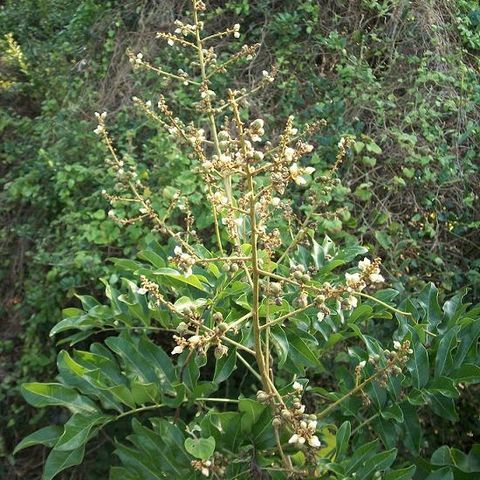Tree or shrub, dioecious, up to 3.5 m high. Leaves paripinnate, large, many jugate, green; leaflets oblong-elliptic, apex acute, margins entire, wavy. Flowers white to cream-coloured, in many-flowered, dense, axillary racemes. Sepals 5, concave, imbricate, pubescent. Petals 5, woolly with red-brown scales on inner surface, ciliate. Disc glabrous. Stamens (8-)12-20, arising within disc; filaments linear, pilose. Ovary 3-lobed; style simple, thick, straight. Flowering time Mar.-Nov. Fruit separating into 2 berry-like mericarps, up to 15 x 10 mm, leathery and brown when mature. Seeds subglobose.
Leaves up to 30 cm. long, petiolate; petiole up to 9 cm. long, somewhat sparsely pubescent (more densely so in the furrows) or glabrous; rhachis terete, often ribbed but scarcely winged, glabrous or sparsely pubescent; leaflets 5–7-jugate; petiolules up to 3 mm. long; leaflet-lamina up to 15 × 5 cm., elliptic to oblong-elliptic, glabrous or nearly so, apex acute (rarely long-acuminate) to blunt, margin entire, base cuneate to rounded; lateral nerves 12–15 pairs.
Shrub, up to 1.5 m high. Lamina elliptic to oblong-elliptic, leaflets 5-7-jugate, petiole 30-90 mm long. Sepals 4.5-5.5 mm long. Flowers cream.
Fruit whitish-yellow; cocci 10–15 × 8–10 mm., subglobose or ellipsoid, sparsely pubescent at first, glabrescent.
Flowers cream-coloured, in short-stalked or subsessile cymules; pedicels 1·5–3·5 mm. long, tomentose.
Sepals 4·5–5·5 × 3–3·5 mm., elliptic to broadly elliptic, very densely fuscous-or silvery-pubescent.
Inflorescence terminal, up to 35 cm. long, fulvous-tomentose or fulvous-pubescent.
Seeds up to 10 × 8 mm., subglobose to obovoid or ellipsoid, glabrous.
Shrub up to c. 1·5 m. tall; branchlets glabrous or soon glabrescent.
Staminodes 14–16 in female flowers with filaments 1 mm. long.
Ovary 3-lobed, tomentose; style 3·5 mm. long.
Petals 4·5–5·5 × 2·5 mm., elliptic, ciliate.
Male flowers not seen.
Disk glabrous.


